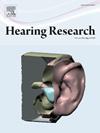Toward an ex vivo preparation for studies of the cochlear active process in mammals
IF 2.5
2区 医学
Q1 AUDIOLOGY & SPEECH-LANGUAGE PATHOLOGY
引用次数: 0
Abstract
The mammalian cochlea benefits from an active process characterized by amplification of mechanical inputs, sharp frequency selectivity, compressive nonlinearity, and spontaneous otoacoustic emission. Similar traits are observed in individual hair cells of nonmammalian tetrapods, in which they emerge from the critical dynamical regime of hair cells operating near a Hopf bifurcation. It remains unclear whether a similar critical regime also underpins the active process of the mammalian cochlea. Efforts to address this question have been limited in part by the absence of an ex vivo preparation that both preserves the physiological integrity of the sensory epithelium and grants direct experimental access to it. To overcome these problems, we improved a two-compartment cochlear preparation (Chan and Hudspeth, 2005a, 2005b) to more closely simulate in vivo conditions and used it to conduct electrophysiological recordings of microphonic signals in isolated cochlear segments of the Mongolian gerbil. Our methodological advances included refining the dissection protocol to reduce the size of the exposed cochlear segment and altering the ionic compositions of the solutions to better control the Ca2+ concentration. We also maintained a constant temperature in order to stabilize the experimental conditions. Most critically, by introducing a mechanism to adjust the pressure in the endolymphatic compartment, we were able to explore how variations in transepithelial pressure influence the electrical response. These changes enabled us to reliably measure compressive nonlinearities with a one-third power law similar to that observed from cochleas in vivo and consistent with the behavior of a dynamical system operating near a Hopf bifurcation.
用于哺乳动物耳蜗活动过程研究的离体制备
哺乳动物的耳蜗受益于一个主动过程,其特征是机械输入的放大、尖锐的频率选择性、压缩非线性和自发耳声发射。在非哺乳动物四足动物的单个毛细胞中也观察到类似的特征,它们出现在毛细胞在Hopf分岔附近工作的关键动力机制中。哺乳动物耳蜗的活动过程是否也有类似的关键机制,目前尚不清楚。解决这一问题的努力受到限制,部分原因是缺乏既能保持感觉上皮生理完整性又能直接进行实验的离体制备。为了克服这些问题,我们改进了一种双室耳蜗制备方法(Chan和Hudspeth, 2005a, 2005b),以更接近地模拟体内条件,并用它对蒙古沙鼠耳蜗分离段的麦克风信号进行电生理记录。我们的方法进步包括改进解剖方案,以减少暴露的耳蜗段的大小,改变溶液的离子组成,以更好地控制Ca2+浓度。为了稳定实验条件,我们还保持了恒温。最关键的是,通过引入一种调节内淋巴室压力的机制,我们能够探索上皮压力的变化如何影响电反应。这些变化使我们能够可靠地测量压缩非线性,与从活体耳蜗观察到的三分之一幂律相似,并且与在Hopf分岔附近运行的动力系统的行为一致。
本文章由计算机程序翻译,如有差异,请以英文原文为准。
求助全文
约1分钟内获得全文
求助全文
来源期刊

Hearing Research
医学-耳鼻喉科学
CiteScore
5.30
自引率
14.30%
发文量
163
审稿时长
75 days
期刊介绍:
The aim of the journal is to provide a forum for papers concerned with basic peripheral and central auditory mechanisms. Emphasis is on experimental and clinical studies, but theoretical and methodological papers will also be considered. The journal publishes original research papers, review and mini- review articles, rapid communications, method/protocol and perspective articles.
Papers submitted should deal with auditory anatomy, physiology, psychophysics, imaging, modeling and behavioural studies in animals and humans, as well as hearing aids and cochlear implants. Papers dealing with the vestibular system are also considered for publication. Papers on comparative aspects of hearing and on effects of drugs and environmental contaminants on hearing function will also be considered. Clinical papers will be accepted when they contribute to the understanding of normal and pathological hearing functions.
 求助内容:
求助内容: 应助结果提醒方式:
应助结果提醒方式:


